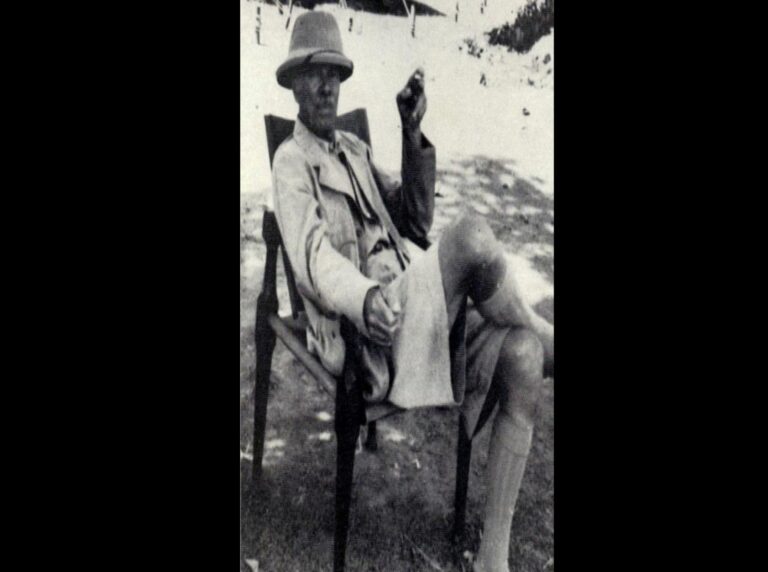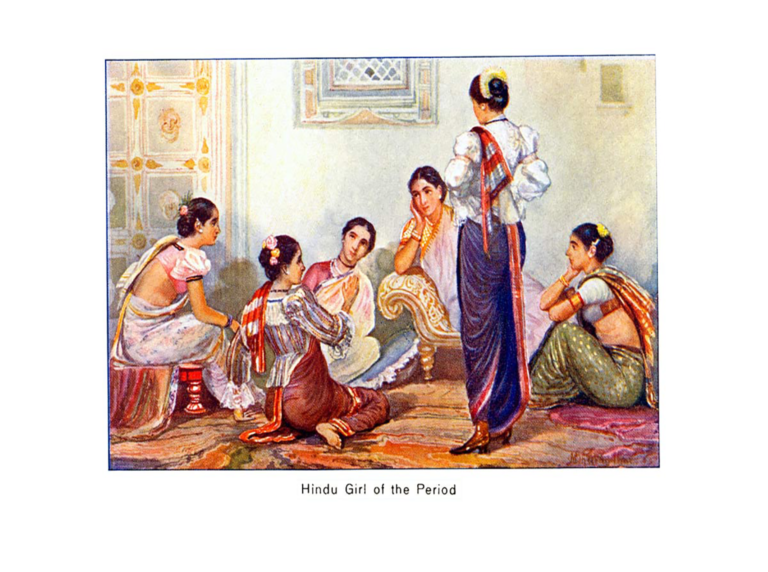Zahid Ali Ansari
Introduction
The Islamic world is very well known of its artistic heritage and traditions, and the Islamic talisman is one of them which in any form demonstrate the merging of cultural, social, religious and artistic practices. It reflects the genius and great accomplishments of the artists and illustrates the rich variety of Islamic art which throughout its history has produced masterpieces. These are the objects that are believed to be imbued with magical properties that empower, guide, and protect their owners from danger, evil, harm, misfortune and sickness; and are a global and culture-wide practice. It is a common belief that objects with Islamic religious motifs, such as those concerning Allah (The Almighty God), or bearing the word Allah (The Almighty God), his ninety-nine beautiful names (Al-Asma al-Husna), the Prophet Muhammad (PBUH), Quranic inscriptions, prayers or religious phrases possess beneficial powers, the magical properties and brings good luck; even who reads, sees or touches it. These Islamic talismans with purely religious inscriptions have a great importance and significance among the followers. The faith in the talismanic power encourages the believers to use it in different forms according to their comfort. There are many collections of Islamic Art in the various National Museums and similar institutions. These are made from a variety of media, and cover a wide variety of items. Here, we are introducing some of the finest specimens of Islamic Talismans: their inscriptions and content, which includes costumes, utensils, amulets and finger rings selected from the collection of National Museum, New Delhi (India).
Gallery
Costumes:
Talismanic Tunic with inscription of Islamic holy verses and praises in Arabic cursive script
India, possibly Deccan
18th – 19th century; Cotton
108 x 132 cm
National Museum, New Delhi; Acc. no: 56.43
High ranking warriors across Islamic empires wore Talismanic tunic underneath their armor to protect them from harm during battle and afforded the wearer a line of mystical defence, as the text of the Quran is sacred to Muslims and is believed to have protective powers. Inscribed with verses from the Quran, the ninety-nine names of Allah- The Almighty God, prayers, and magical formulas. These shirts were also called “victory shirts” or the “armor shirts” and generally were in trend from fifteenth to nineteenth centuries.
This cotton hand-painted talismanic tunic has round neck, front opening, up to waistline, sleeves up to three-fourth in length, slightly flared skirt portion and tying system of fabric tassels on sleeves, armpit and waistline. The flared skirt portion of this talismanic tunic is special, which makes it slightly different from others. Every inch of this talismanic tunic is covered with hand-written inscriptions in Arabic cursive script filled with Quranic passages and other Islamic writings.
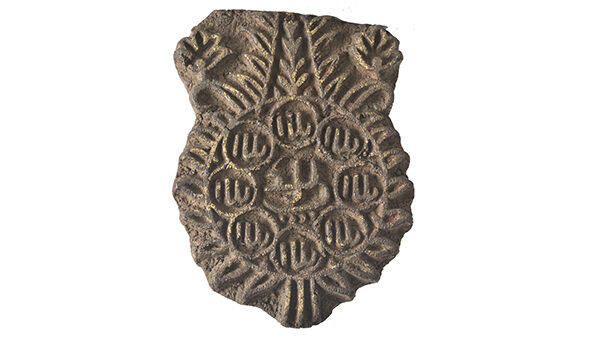
Printing block carved with the name of Allah (The Almighty God) and Ali (the fourth caliph of Islam) in decorative form
India, possibly Deccan
19th century; Wood
6 x 9 x 6.5 cm
National Museum, New Delhi; Acc. no: 85.195
Indian craftsmen are very much skilled who carve wooden blocks to form fine designs and patterns on its surface. The printing through these carved wooden blocks remains a popular way to create beautiful designs and patterns on textiles in countries of South Asia, especially in India. It is one of the earliest methods of textile printing, used mostly on silk and cotton fabric. The designs and patterns are usually inspired by floral motifs, geometrical shapes and are orderly, symmetrical, detailed, and intricate. To print the pattern, the printer dipped the block into dye and stamped onto the fabric with swift and practiced precision.
This wooden printing block with a handle for easier handling during the printing process is beautifully carved with the name of Allah (The Almighty God), eight times in small circle around the inscription Ya Ali (the fourth caliph of Islam) in very decorative form.

Choga style over garment (farji) woven with inscription of God blessing to the wearer in Arabic cursive script
India, possibly north India
19th century; Silk, metal threads (zari)
110 x 160 cm
National Museum, New Delhi; Acc. no. 62.2918
The choga style over garment known as farji, tailored from the maroon colour silk-metal thread (zari) brocade, has front opening with raised collar, full sleeves, slightly flared skirt portion and overlapping of right panel on left panel. The ogee arches pattern worked in both gold and silver thread (ganga-jamuni technique) all over the field and were usually produced in Varanasi centre, Uttar Pradesh, India. It has been worked with inscription in silver metal thread, while ogee arch pattern in leaf style with gold metal thread (zari). Probably, an especially commissioned garment illustrates a prayer (Dua) in Arabic cursive writing Baraka Allah kum Sayyed (Allah-The Almighty God, Bless You, O Syed).
Utensils:
Dish/ plate with inscription of Islamic holy verses in Arabic cursive script
India, possibly north India
1012 AH/1604 CE ; Copper
Ht. 3; Dia. (top) 25.8 cm
National Museum, New Delhi; Acc. no: 62.111
This dish illustrates nice composition of Holy verses from Quran within the central circle and on broad border of the slightly raised edges in Arabic cursive script, which is further enclosed within beautiful floral creeper and diamond pattern design. The raised edges of the dish illustrates a famous small chapter of Holy Quran called Throne verse (Ayat-al-kursi). It is the most famous verse of the Quran and is widely memorized and displayed in the Islamic world due to its emphatic description of God’s power over the entire universe, often recited as a defence against fear. The central portion is inscribed with Bismilla hir rehma nir raheem (In the name of Allah (Almighty God), most gracious most merciful) along with a date 1012 AH / 1604 CE. It is believed that “Any important work that does not begin with Bismillah is imperfect”, hence Muslims always read it before beginning of any project or work.

Bowl inscribed with the name of Almighty God Allah and of 12 great messengers of Islam in Arabic cursive script
India, possibly north India
19th century; Jade
Ht. 5.7; Dia. 9 (top) cm
National Museum, New Delhi; Acc. no: 62.2970
This small jade cup with raised open mouth and ring base is a good example of the belief that God’s magical powers attached to it will solve their problems. There was also a belief that jade itself possessed properties of healing. The inner surface of the cup is plain, while the exterior is fully engraved with twenty-four vertical bands inscribed with the names of The Almighty God-Allah (Ya Allah, Ya Raheem) and names of 12 great messengers of Islam- Hazrat Adam, Hazrat Shis, Hazrat Nooh, Hazrat Hud, Hazrat Saleh, Hazrat Loot, Hazrat Shoeb, Hazrat Ibrahim, Hazrat Yaqub, Hazrat Yusuf, Hazrat Zakaria, Hazrat Yahya (peace be upon them) in Arabic cursive script along with the row of flower petal around the rim and the base.

Bowl with inscription of Islamic holy verses in Arabic cursive script
India, possibly north India
Late 19th century; Brass
Ht. 5, Dia. (top) 16.4 cm
National Museum, New Delhi; Acc. no. 63.1489
A bowl with flared mouth, edged rim, raised projected knob on the inner side and a ring base. It has beautifully inscribed bands with Arabic cursive script in bold and minute letters alternatively and the beauty of the inscriptions on bowl is due to the way the text was arranged on the surface and also the way it was designed to produce, a sort of rhythm. It has various holy verses and a number of small chapters from the Holy Quran all over its surface such as the opening chapter of Quran – Surah al-fatiha (which serves as a great purpose of asking the Almighty for granting one attainment of the right path), Throne verse: Ayat-al-Kursi and the four short chapter called “the four declaration” (Quls), all worked in chasing technique. It has forty additional small flat leaf-shaped hangings attached through a wire and all are inscribed with Bismillah (I begin in the name of Allah).
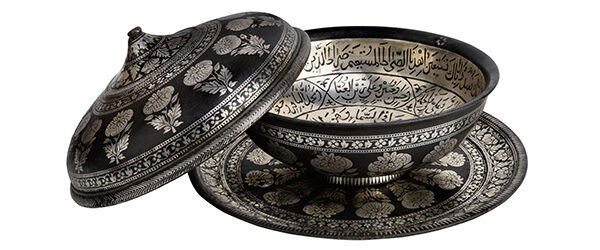
Water drinking Bowl (Abkhora) with lid and plate inscribed with Islamic holy verses and a praise (recite by Shi’ite Muslims) in Arabic cursive script
India, Telangana, Hyderabad
Late 19th century; Bidri (alloy), silver
Ht. 5.5, Dia. (top) 14.2 (bowl); Ht. 5.4, Dia. 14.8 (lid); Dia. 18 (plate) cm
National Museum, New Delhi; Acc. no. 59.115/11 (a,b,c)
This complete set of Water drinking bowl (abkhora) with lid and a plate is an example of Bidri ware workmanship. Bidri is a metal alloy of mainly zinc and copper where surface ornamentation was done with other materials such as silver or gold.
The popular poppy pattern is depicted on all around the exterior portion of bowl, bowl’s lid and on the plate along with floral scrolls. This pattern was the most popular motif appeared on textiles and decorative objects under the Mughal rule from seventeenth century onwards. The inner portion of the bowl is inscribed in Arabic cursive script with the verses from Quran, praising and appeals to God such as small chapter Surah al-Fatiha and praise/invocation (Durood). There is a belief that drinking water from such a bowl has a healing power and would protect the drinker from evil and imbibe them with extra strength and user will be blessed by the Almighty God.
Amulets and Finger Rings:

Amulet with inscription of Islamic holy verses in Arabic cursive script
India, possibly north India
Early 19th century; Carnelian, turquoise, silver
3.9 x 3.0 x 1.0 cm
National Museum, New Delhi; Acc. no: 59.14/209
This amulet is having an inscribed carnelian encased within ornamental silver frame with loops and is studded with turquoise beads. It has the inscription of the holy verse of Quran- Surah Al-Ikhlas believed to be equivalent to recite one-third of the holy Quran. It contains the attributes of the most compassionate – The Almighty God, Allah. It is believed to be a means of attaining the love of Allah, increasing of one’s Rizq (anything that brings benefits or goodness to us) and reciting Surah- al- Ikhlas when entering ones house is that poverty will be eradicated. It is a means of forgiveness of one’s sins and of increasing the presence of the angels at the time of death. The meaning is as follows- “Say: He Allah (The Almighty God) is one; Allah the Eternal, He begets not nor is He begotten, and there is none like unto Him”.

Amulet inscribed with some of the beautiful names of Allah, The Almighty God (Asma al-Husna)
India, possibly north India
19th century; Carnelian, turquoise, silver
3.4 x 5.0 x 1.2 cm
National Museum, New Delhi; Acc. no: 60.976/2
An amulet having an inscribed carnelian encased within ornamental silver frame and studded with turquoise beads. This fine amulet has the inscription in Arabic cursive script beautifully distributed in five lines and probably seems to be a commissioned piece. It is bearing various benevolent names of Allah (The Almighty God) such as – “Ya Hafiz (O The Guardian /O The Commander), Ya Rab, Ya Malik (O The Lord), Ya Kabir, Ya Azim (O The Great Lord) Ya Qadir (O The Powerful / O The Capable) Ya Qawi (O The Great Power), Ya Aziz (O The Magnificent), Ya Jameun (O The Gatherer), Ya Naafeun (O The Propitious), Ya Waseun (O The All-Encompassing), Ya-Razzaqun (O The Provider), Ya Noorun (O The Light) and so on”. It is considered by the believers that whosoever recite, or memorizes and embrace names of Allah (Asma al-Husna) will enter heaven.

Bracelet with inscription of Islamic holy verses in Arabic cursive script
India, possibly north India
19th century; Carnelian, silver
1.7 x 13.2 x 1.2 cm
National Museum, New Delhi; Acc. no: 60.1597/45
A bracelet consist of seven carnelian oval plaques of white, orange and yellow color, mounted individually within silver frame, which are joined together. All the seven stones of the bracelet are inscribed with the selected holy verses (ayat) of the Quran and these are very popular for their talismanic properties. The meaning of these verses are as (from right to left) :
“No doubt Allah (The Almighty God) is powerful on all things; With the help of Allah (The Almighty God) victory is near; There is none worthy of Worship besides You, You are far exalted and above all weaknesses, Surely, I am from among the wrongdoers; In the name of Allah the most gracious and merciful; Say: He Allah (The Almighty God) is one, Allah the Eternal, He begets not nor is He begotten, and there is none like unto Him; I recommend all my acts to Allah (The Almighty God) and Allah (The Almighty God) is very much helpful to His slaves; No doubt Allah (The Almighty God) is powerful on all things”.
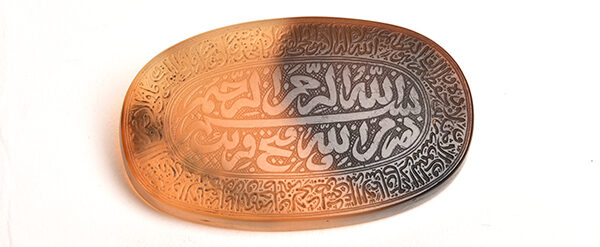
Amulet with inscription of Islamic holy verses in Arabic cursive script
India, possibly north India
19th century; Carnelian
2.7 x 4.5 x 0.5 cm
National Museum, New Delhi; Acc. no: 60.1597/54
An oval shaped carnelian having very fine inscription illustrating holy verses from Quran all over the surface, bold letters in center while the minute letters along the edges in Arabic cursive script. The minute inscription illustrates one of the most popular verses from Quran – Throne Verse (Ayat al-Kursi), a fundamental statement of divine power. It is believed that in Ayat Al-Kursi there are fifty words and for each word there are fifty blessings and good in it; which signifies its importance in Islam. In center, it has the inscription of Bismillah and Nasrum minallahe wa fathun qareeb (With the help of Allah (The Almighty God) victory is near). This inspiring verse gives believers solace to the heart, brightens hope, cheers up when we feel low and increases faith in God and generally recite or used by Muslims for perfect motivation to endeavor, to achieve success, glory and happiness.

Finger Ring with inscription of Islamic holy verses in Arabic cursive script
India, possibly north India
19th century; Carnelian, silver
2.2 x 2.3 x 1.8 cm
National Museum, New Delhi; Acc. no: 63.490/22
This ring is having a flat, rectangular bezel with a setting of red colored carnelian firmly hold by the prongs around the edges. The surface is covered with inscriptions with cursive Arabic script including a selection from the 99 beautiful names of Allah (Asma al-Husna) at the center within a rectangular frame, surrounded by the first chapter and the most influential one, written in the holy book Quran (Surah al-Fatiha). It is considered by the believers that whosoever recite, or memorizes and embrace Asma-al-Husna will enter heaven while Surah al-Fatiha, is almost the complete essence of the Islamic faith, i.e. Believing and Admiring the Exalted One (Allah), and asking Him (Allah) only for gaining rectitude in life.

Finger Ring with inscription of Nad-e-Ali (a praise recite by Shi’ite Muslims) in Arabic cursive script
India, possibly Deccan region
19th century; Stone, silver
2.1 x 2.1 x 1.8 cm
National Museum, New Delhi; Acc. no: 63.490/1
The ring is having a flat, oval bezel with a setting of a green colored stone. It is inscribed with holy inscription Nad-e-Ali in four line in cursive Arabic script and all within an oval shaped line border. Nad-e-Ali, is the auspicious one which is very common on talismans, featuring indeed on many minor Iranian objects from the 16th to 19th centuries and also, towards and end of 20th century, on objects from India. The meaning as follows:
“Call Ali, the manifestation of wonders, You will find him helpful in calamities, All worries and anxieties will disappear with your Greatness O Allah (The Almighty God), With your prophet-hood O Muhammad (PBUH), with your succession O Ali, O Ali, O Ali”.
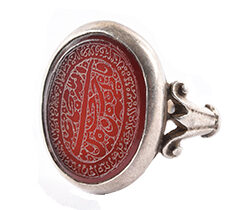
Finger Ring with inscription of Islamic holy verses in Arabic cursive script
India, possibly Deccan region
19th century; Carnelian, silver
1.9 x 1.9 x 1.5 cm
National Museum, New Delhi; Acc. no: 60.1597/19
This ring is having a flat, oval bezel with sloping edge and a setting of a red (maroon) colored carnelian. The gem is engraved with cursive script in positive within two concentric oval line borders. The central part inscription is little raised against the background and is inscribed with the name of Allah and names of the holy Five (Panjtan Paak), i.e. Prophet Muhammad (PBUH), Hazrat Ali, Hazrat Fatima, Hazrat Hassan, and Hazrat Hussain. The outer one of the gem has a holy chapter from Quran (Surah- al- Ikhlas). It is believed that there is a great reward who recites Surah- al- Ikhlas as it is a means of entering Paradise and of attaining the love of God. The meaning of this holy chapter is – “Say: He Allah (The Almighty God) is one; Allah the Eternal, He begets not nor is He begotten, and there is none like unto Him”.
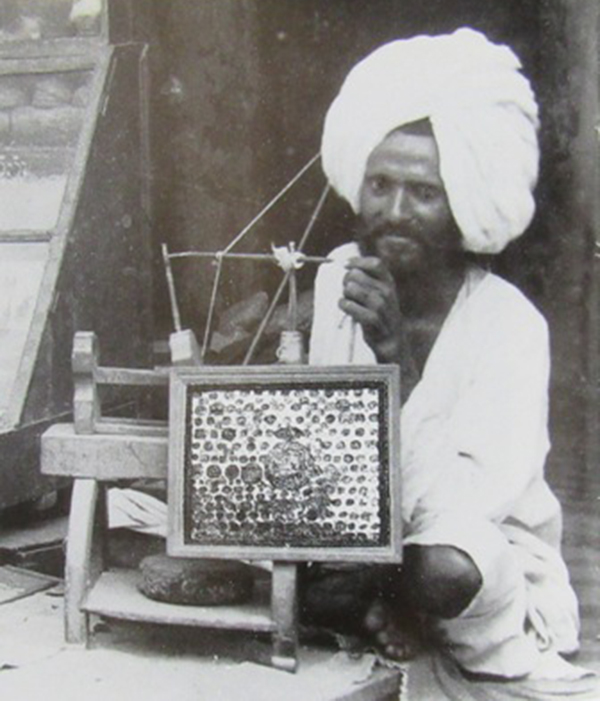
Seal carver (Muhr-kand)
India, Delhi
Late 19th century
Photo courtesy
Collection the author, Porvoo
Oppi Untracht, Traditional Jewelry of India. London: Thames and Hudson, 1997, 262, 610
Stone (seal or amulet) engravers known as muhr-kand plied their trade in this special branch of lapidary work in every major city and in provincial government centers. Dariba bazaar in Delhi, remains a center of the jewelry trade, was the place where the generations of superior stone engravers made this work a local specialty. These stone engravers made seals as well as also executed the texts on Muslim stone stud amulets.
This photo of a seal carver is of late 19th century at Dariba Bazaar, Delhi, sits behind his weighted carving lathe before which, to illustrate his skill, is a framed paper bearing imprints of seals he has made. The stone carvers were the most famous in India because of their skill in making highly aesthetic calligraphic Arabic, Persian and Urdu inscriptions.
Acknowledgement
- Ministry of Culture, Government of India.
- National Museum, Janpath, New Delhi, India.
- Dr. Madhuvanti Ghose, Alsdorf Associate Curator of Indian, Southeast Asian and Himalayan Art, The Art Institute of Chicago, U.S.A.
- Dr. Vandana Sinha, Director, Center for Art and Archaeology, American Institute of Indian Studies, Gurugram, Haryana, India and her all team members.



